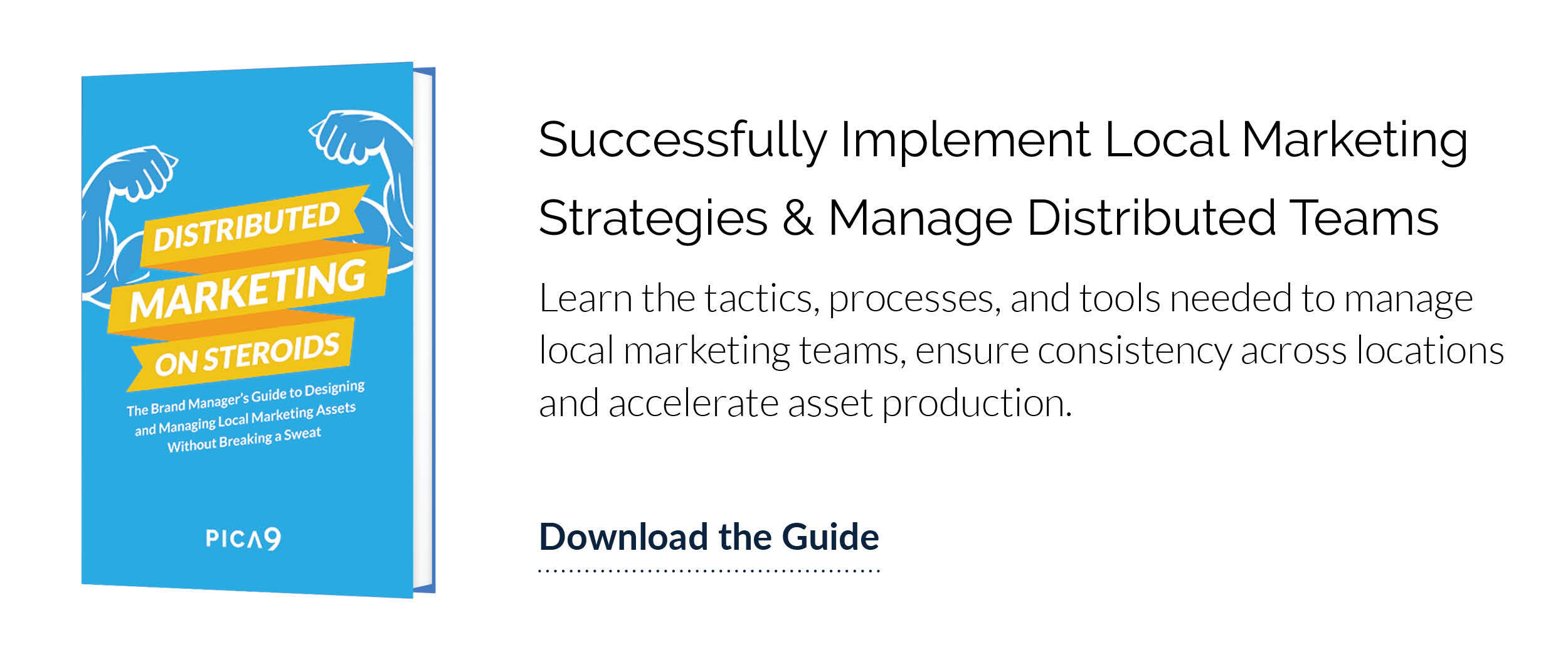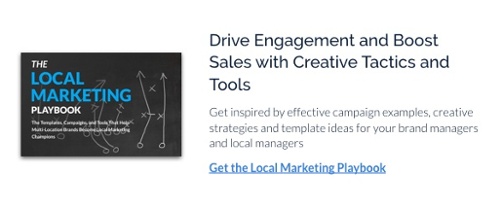As a brand manager, you’re all too familiar with the task of slicing and dicing your limited budget into an annual distributed marketing strategy. Your marketing budget needs to be spread out across quarters, campaigns and brand assets. Planning has to involve using funds across the entire year, instead of running out in the third quarter.
The most effective distributed brand managers don’t necessarily have more funds than your team. Most likely, they’ve unlocked secret strategies for maximizing the budget they do have across their assets and local campaigns. Read on to learn how to reset your thinking, and create assets for killer local campaigns.
Leverage Brand Assets: 3 Secrets
Secret #1: Think "Creative but Consistent"
The best distributed marketing campaigns include a mixture of consistency and creativity. The idea of striking a balance between global brand promise and fresh, relevant messaging may be key to some of the world's most effective distributed campaign designs at the brand management level.
The idea of balancing creativity and consistency is modeled by many distributed brands, including fast-and-casual franchise Subway. Their latest messaging is about adding "color to your day" with heart-healthy vegetable offerings. While it's a new, creative way for the brand to connect with health-conscious customers, it's still consistent with their long-standing slogan of "eat fresh."
This idea of presenting the same brand promise in new, engaging ways is the framework for campaign design. Even if your restaurant or hotel brand has holiday-themed campaigns every December, adding a new twist can keep it interesting for your customers.
Chances are, your local marketers are already used to adding a creative twist to your national brand. That's why even very well-defined brands may offer variations, such as different menu offerings or services, to suit local preferences.
In HotelExecutive, one hospitality director shared how his local properties are encouraged to "adjust their offerings to reflect the local culinary culture." This means the breakfast buffet may feature dosa in India and baked beans in Great Britain. When presented in the context of the quality and experience customers expect from the brand, these local variations have a substantial impact on satisfaction.
The same idea of variation without subtracting from the overall brand promise, is what's important to campaign design.
As brand management teams work to develop new and innovative campaign concepts, you should strive to find the balance between consistency and creativity. Maintain the foundational elements of your branding and values, while thinking of a new, fresh take on each seasonal campaign you develop. By considering how your local marketers can add local relevance to these campaign concepts, you can achieve even better local adoption of your assets, as well.
Secret #2: You May Be Thinking About Marketing Mix the Wrong Way
Marketers obsessively dig into studies about the optimal marketing mix. They want to know how the most effective brands are using digital, print and broadcast, and how much money they’re allocating to email over social advertising.
Everything you've learned about the complex factors that determine marketing mix optimization is still true. As is demonstrated in books like Contingency Factors of Marketing-Mix Standardization, marketing mix optimization is really a quantitative science that depends on your organization, industry, and other factors.
While the ultimate goal of your brand's marketing will be to drive sales, the way you approach national and local campaigns will most likely differ. At a national level, you’ll probably have heavy digital and broadcast marketing. Local marketers are going to rely extensively on print and out-of-home media (OOH) methods, with less digital and broadcast.
Break down each channel - how much are local marketers using email, banners, or direct mail. Once you have an understanding of how the local marketing mix shakes out, you can use this context to guide your marketing strategy to help determine which assets will be most effective for future use. By creating assets in proportion to the way you think the marketing mix should be, you will end up creating assets that your local markets will love.
Secret #3: Anticipate Local Marketers' Needs and Configure Collateral Management Systems Accordingly
Successful local marketing execution is a little more emotional than great campaign concepts at a national level. Your brand management team and local representatives both have the same goals in mind: trying to capture the hearts, minds, and wallets of local consumers. However, the road to success is going to look a little different on a local level.
National campaigns need bulletproof messaging.
Local campaigns need to build on shared experiences with local consumers, who are used to interacting with your brand on a local level.
Brand managers need to make it easy for local marketers to understand, find, and use local marketing assets. If your local reps can’t find the right assets, or end up using the wrong ones, your brand consistency is at stake. As far in advance as possible, brand managers should think about local marketers’ needs and perspective. They need to quickly turn templates into assets for great campaigns. They need fast execution, with flexibility to customize specific kinds of assets. This is where smart marketing collateral management practices, such as adopting a digital asset management tool (DAM) come into play.
With an all-in-one local marketing automation tool, graphic designers can achieve efficiency in connecting existing brand assets to new campaigns. Brand managers can get faster at approval, and more effective at assigning assets to the right local markets.
The efficiency carries over to the end users, your local marketers, as well.
With the right local marketing tool, your local outlets have the ability to log in, quickly see the assets available by campaign, make updates and execute them, all from a single marketing portal.
There's also a potential for higher asset return-on-investment with the right technology. A single photoshoot can cost thousands of dollars. If the assets are mislabeled, or lack metadata, it can be difficult for both internal graphic designers and local marketers to find and reuse collateral. DAM tools can drive productivity gains and cost-savings as organizations improve their average time to find assets and achieve higher re-use rates.
Unlocking Consistently Winning Distributed Marketing Campaigns
As a distributed brand manager, you face many of the same challenges as your peers, regardless of whether you're in hospitality, dining, retail, or any other industry. You all have to work with a limited budget to develop creative campaign concepts, create the right marketing mix of assets, and systemically manage collateral. Luckily, using a combination of technology and the distributed marketing campaign secrets discussed here, you can to develop winning campaigns and assets consistently.
With local marketing automation tools and smarter marketing collaboration management practices— brand managers can balance fresh ideas and brand consistency in planning, achieve the right marketing mix, and ensure that local marketers have access to the right assets.
Get more inspiration for distributed brand assets and campaigns. Grab our free eBook: Distributed Marketing on Steroids: The Brand Manager’s Guide to Designing and Managing Local Marketing Assets Without Breaking a Sweat.





